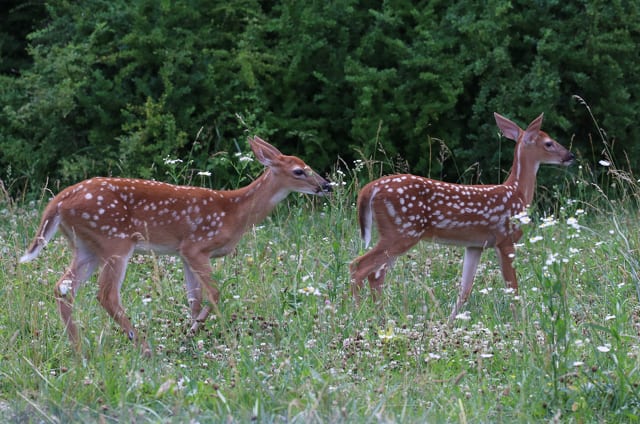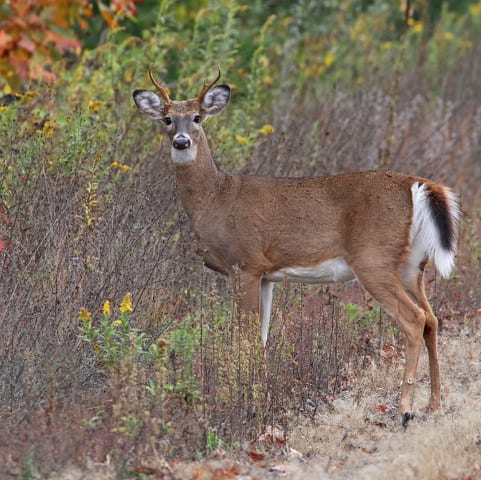
no description

no description
A doe with twin spotted fawns enjoying the summer sun, a 10-point buck attempting to sneak past a hunter — these are visions that bring a smile to most people’s faces. The white-tailed deer, our official state animal, is a common sight for most residents of central Pennsylvania. Living where I do in rural Centre County, it is a rare day that I do not see a deer. However, this was not always the case.
Native Americans utilized deer for food, clothing and shelter. Pennsylvania’s early settlers also depended on deer for food. Extensive logging for lumber, tannin and charcoal making, a conversion of the landscape to farming, as well as unregulated hunting, greatly reduced deer numbers in Pennsylvania.
Just over a century ago, deer were in trouble. In 1895, the year that the Game Commission was formed, the legislature reduced the deer season to two months — Oct. 15 to Dec. 15, but with no enforcement to which few paid any attention. By 1900, there were hardly any deer in Pennsylvania — large areas of the state had no deer at all. This persisted for many years. Fellow outdoor writer Ben Moyer related that growing up in southwestern Pennsylvania, it was rare for him to see a deer or even a deer track.
The Pennsylvania Game Commission was formed largely to protect deer. Some people did not go along with the whole idea of deer hunting restrictions. In 1903, the first game warden was shot, and three more were shot in 1904. In 1907, seven officers were shot — three fatally. That same year, a bucks-only season was established and fewer than 200 bucks were harvested in the entire state.
Fortunately, laws were enforced, and people wised up. The deer population grew. By 1920, the buck harvest was 3,300. Compare that to the present. During the 2019-Jan. 2020 seasons, an estimated 389,431 deer were harvested, with approximately 163,000 being bucks. Deer seasons in 1920 were 12 days long — today they span several months.
An adult male white-tailed deer stands about 32 to 34 inches tall at the shoulder — much smaller than most people think. Bucks are slightly larger than does. Deer weights vary with age, sex, time of year, health and diet. In Pennsylvania, a 2.5-year-old buck might weigh around 150 pounds. Generally speaking, deer get bigger as you go north to Maine and slightly smaller as you go south towards Florida. Except in rare cases, only male deer have antlers. Their antlers drop off during the winter and they re-grow new ones each spring.
White-tailed deer get their name from the snow-white underside of their tail. “Flagging” their white tail is used to signal danger to other deer and it is also a type of protective coloration. It draws a hunter’s attention and allows deer to disappear when the tail is dropped.

Photo by Mark Nale | For the Gazette
White-tailed deer have a brownish-red coat of fur in the summer and a much thicker brownish-gray coat during the fall and winter. This color provides a near-perfect camouflage. Deer are perfectly adapted to Pennsylvania winters. They store fat in the fall and their thick hollow fur provides excellent insulation.
Deer have no trouble surviving typical Pennsylvania winters, with one exception. They have a very hard time navigating snow that is covered with a thick icy crust — so thick that their hooves cannot break through, nor get a grip. I have witnessed this only once in my lifetime here in Centre County, around 1980 or 1981, when a thick coat of ice persisted for several weeks. Many deer were injured in falls and died that winter.
Deer are considered browsers, rather than grazers. However, they eat a wide variety of herbaceous and woody plants. They eat both hard and soft mast — including acorns, beechnuts, apples and pears.
The white-tailed deer’s mating season, called the rut, reaches a peak in mid-November, with most fawns being born during the last week of May and the first week of June.
Adult does typically have twin fawns, with the number having triplets about equal to the number of does giving birth to only one fawn. Newborn fawns are the most susceptible to predators. Here in Pennsylvania, their major predators are coyotes, black bears and bobcats.
Deer have a huge economic impact in Pennsylvania. The vast majority of people who purchase hunting licenses do so to hunt white-tailed deer. And then you have gun, ammo, and equipment sales — all centered on deer hunting. Venison is an important source of protein for many hunters’ families. Through Hunters Sharing the Harvest, it has also been an important protein source for many less fortunate families.
However, deer also have a negative economic impact. Ask any farmer about the damage that they do to crops — corn, clover, alfalfa, wheat. Deer impact forest regeneration. They affect the composition of tree species and, when their numbers are high, they can eliminate forest regrowth altogether. Then, there is the damage done to landscape plantings – shrubbery, household gardens and more.
Pennsylvania has a lot of people, a lot of roads and a lot of deer — so it should be no surprise that we are always ranked number one or number two among the states with the highest number of deer-auto collisions. This is yet another negative economic impact for most people, but not for auto-body shops.
The deer population can double in one year. Although you might not be a hunter or even a fan of hunting, it is annual hunting seasons that help to limit crop damage, deer-vehicle collisions, and damage to the habitat. Consider thanking a hunter for the service that they provide in keeping deer populations in check.
Receive all the latest news and events right to your inbox.

80% of consumers turn to directories with reviews to find a local business.